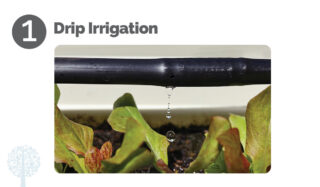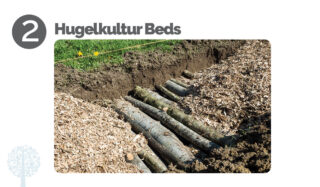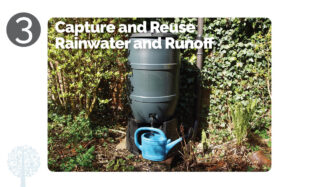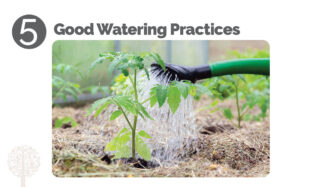5 Cool Ways To Maximize Water In The Garden
Watering the garden is one of the most basic tasks growers have, yet it’s also one of the most complex. We hope you’ve gained a wealth of knowledge from this edition regarding water and how to best offer it to your plants. In the era of climate change, this precious natural resource is a concern for us all, so we’d like to cap things off by suggesting 5 Cool Ways To Make The Most Of Your Water. These recommendations benefit us, our gardens, and the planet.
Drip Irrigation
Drip irrigation involves using a series of hoses and tubes strategically placed at the base of plants throughout container gardens, raised beds, or in the ground. The gardener attaches a hose bib or sprinkler valve, and multiple plants simultaneously receive water. Some growers shy away from drip irrigation because the concept may initially seem overwhelming. But in reality, this method is easy to install, saves time and water, and offers several other benefits to plants. Drip irrigation allows water to slowly seep down to the roots where crops need it the most. As a result, it minimizes the risk of diseases like powdery mildew and blight and reduces evaporation, quenching the garden’s thirst for longer. Hand watering takes a lot of time, but with drip irrigation, you only have to turn the water on and let the hoses handle the rest. You can purchase ready-to-go kits and set a timer for automated garden watering! Now, that’s what we call smart gardening.


Hugelkultur Beds
We can’t emphasize enough how efficient hugelkultur beds and containers are for the eco-friendly and water-conscious gardener. Building this type of garden involves layering slow-to-decompose materials at the bottom of the bed or container, like rotting logs, woody stems and branches, egg shells, and fruit pits. Top these materials with leaf mold, compost, and manure, and get planting! If you use rotted logs, you’ll notice how well they retain moisture, which is slowly released to plant roots. Trust us; we’ve tried building garden beds this way and loved the results, with Garden Culture’s editor noticing she didn’t have to water her crops even on the hottest days! If you’re not interested in building a hugelkultur bed, consider simply placing decomposing wood at the bottom of your beds or containers for water retention (and to reduce the amount of soil you’ll need!).


Capture and Reuse Rainwater and Runoff
Sometimes, when it rains, it pours, so why not make the best of a storm and capture water for later use in your gardens? Capturing water can be as simple as putting buckets and wheelbarrows on the lawn before the rain starts. Others use rain barrels with a capacity of about 50 gallons to collect and store rainwater. Install the barrel near a downspout; if using the water for edible crops, a metal roof is ideal, as many roofing materials contain petroleum. A wicking bed is another option that requires some preparation but pays off in the long run. This type of garden features a reservoir that captures and holds water runoff throughout the growing season. Make the reservoir base with an impermeable barrier. Drainage pipes allow the water to flow, and gravel stores the water. Plants drink water from the reservoir as needed, resulting in less evaporation and water waste.


Garden Ollas or Clay Pots
Our ancestors were clever and had a waste not, want not mentality; in the era of climate change, we need to adopt that mindset again. With experts predicting water will become more expensive or difficult to access, looking to our past for smart water-saving techniques is necessary. Many farmers in dry parts bury water ollas or unglazed clay pots because they are porous and water can pass freely through them. All you have to do is dig a hole in the garden for the pot, fill it with water about once a week, and cover it with a clay saucer or another pot to act as a lid. Ensure the lid sits at the soil surface so you can fill it with water. Place ollas 3 to 5 feet apart, depending on the crop type you’re growing. Ollas will offer plants extra water during dry spells and increase the time between watering. They’re an excellent option for containers as well. For large containers, use a 6-8-inch olla. In a garden bed, consider burying several 8-12-inch ollas.


Good Watering Practices
Good watering practices will help you be more efficient and reduce water waste. For example, water the garden only early in the morning or late when the sun sets. Getting your timing right will allow the water to soak into the soil rather than evaporate with the day’s heat. Another good rule of thumb is to water for longer, less often. With a deep soaking, you’ll notice the water pools at the plant’s base and then slowly disappears into the soil. If you do a quick watering, the roots will likely never feel the moisture, which will be quickly absorbed by the soil at the surface. Finally, never underestimate the importance of mulch. Placing compost, fallen leaves, or straw around the base of your plants (but not touching!) will protect the soil from erosion, nutrient leaching, and water evaporation. A quick tip: water before applying mulch to keep the moisture in the ground longer.


Sources:
- The Climate Change Garden: Down To Earth Advice for Growing a Resilient Garden by Sally Morgan and Kim Stoddart.
- Organic Gardening for Everyone by Calikim
- The Regenerative Garden: 80 Practical Projects for Creating a Self-sustaining Garden Ecosystem by Stephanie Rose




